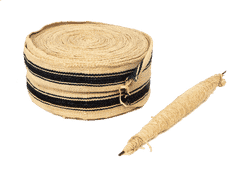Presented by Museum of the Peace Corps Experience and American University Museum
Bale of cloth (left)
c. 1982–83
Yarya, Kono District, Sierra Leone
Cotton, 4 x 9 x 9 in.
Courtesy of Christine Pearson-Musa,
Sierra Leone, Yarya 1981–83
Spindle (right)
c. 1981–83
Yarya, Kono District, Sierra Leone
Cotton thread, 1 1/4 x 1 1/4 x 14 in.
Courtesy of Christine Pearson-Musa,
Sierra Leone, Yarya 1981–83

People in rural villages in Sierra Leone supplemented manufactured clothing with garments made from locally grown cotton. After I observed the process of making clothes during the early 1980s, I appreciated the craftsmanship that was involved.
The cotton bolls were deseeded, and the women spun the fiber into heavy thread using a drop spindle. They dyed the thread in shades of blue, brown, or black, and then the men wove it into fabric on handmade looms. It was sold in smaller pieces, called bales—each 4 inches wide and about 20 yards long—which the seller measured by extending his arms sideways and counting out 10 full arm lengths. The tailors, all men, sewed the 4-inch strips together with a foot-pedal sewing machine. This fabric, called country cloth, was used to make clothing and blankets.
I worked with rural farmers to build fishponds. In the upcountry area of Sierra Leone where I lived, men and boys wore tunic- or hip-length country cloth shirts, short pants, and caps. I wore long pants and occasionally a country cloth shirt. (Although the women did not wear country cloth, I ordered some shirts, and no one objected when I would appear in one.) I never wore shorts because women were not supposed to show their legs—and also because I rode a motorcycle so I could travel to wherever I was needed.
I was surprised that the handspun fabric was not too warm for the tropical temperatures considering that we were eight degrees north of the equator. Garments made from country cloth were thick, but because they were 100-percent cotton they were comfortable in the heat.
Cotton may function as one of the pillars of global manufacturing, but it also represents the inventiveness of small communities of spinners, weavers, and tailors. I admired the artisans in my village, and I grew to love the country cloth of Sierra Leone. I understand that cotton no longer is grown and homespun clothing has become rare in Sierra Leone. Sadly, the weaving of country cloth is becoming a lost art.
Museum of the Peace Corps Experience
PO Box 2427
Oregon City, OR 97045
USA
The Committee for a Museum of the Peace Corps Experience is a 501(c)(3) private nonprofit organization. Tax ID: EIN # 93-1289853
The Museum is not affiliated with the U.S. Peace Corps and not acting on behalf of the U.S. Peace Corps.
Museum of the Peace Corps Experience © 2024. All Rights Reserved.